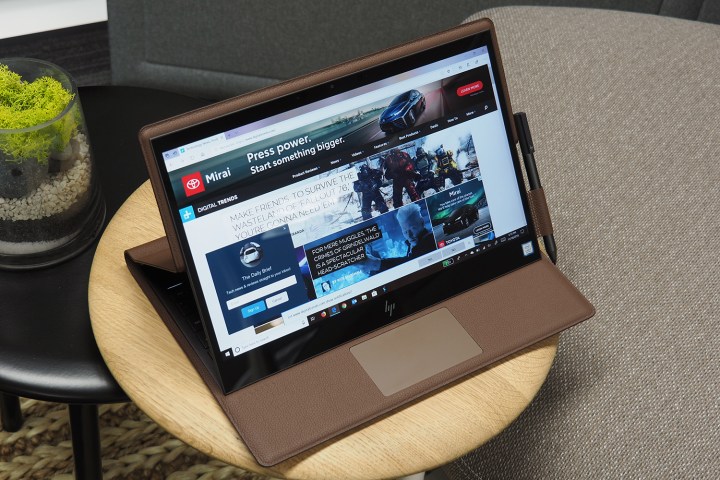
As a laptop reviewer, I’m often spending time with the latest and greatest devices. Laptops that push the envelope in design and performance, and lately, even those with a more adventurous form factor. Not all these are successful, but one that sticks out in my mind over the past year or so is the HP Spectre Folio, a convertible 2-in-1 literally constructed of leather.
The device seemed gimmicky at first blush, but as I noted in my review, it was far more than that. The feel was luxurious, the battery life was outstanding, and the 2-in-1 functionality was actually convenient. But as I’ve noticed, in the past five months of using this laptop, it’s gone from merely a successful experimental device to the laptop I find myself turning to most. Here’s why.
What is it like to use a leather laptop? It’s not too cool

When you first pull out a laptop in the morning, and before you fire it up, that metal chassis can be downright frigid. That’s been particularly true this past spring, which has been unseasonably cool in the Los Angeles area. It might be a first-world problem, but nonetheless — it’s not always the most comfortable experience.
The Folio, on the other hand, stays warm to the touch even after it’s sat idle through a cool Southern California evening. And generally speaking, it’s downright inviting — you find yourself enjoying the process of using it and carrying it around. Sounds crazy, right? But that’s what leather does — it feels nice, which is why the material is used in so many things that we hold and handle.
Metal also conducts heat, meaning that it can be uncomfortable on a lap during intense bouts of productivity. The Folio’s leather chassis does just as good a job of insulating from heat as it does fending off the cold.
In addition, the leather has held up remarkably well. I’ve noticed a few areas where the leather is nicked, but they’re barely noticeable. On a metal laptop, those spots would be dings or scrapes that would stand out a lot more. The Folio’s leather also resists stains, including the normal buildup that metal laptops inevitably develop on the keyboard deck. There’s not a fingerprint to be found, and the leather looks as good today as it did when I pulled it out of the box. Most laptops can’t say the same after several months of use — or even less.
Finally, the leather is incredibly easy on the palms. Some laptop wrist rests, especially on machines with tiny bezels, don’t stick out far enough. They can present sharp edges that become uncomfortable over long typing sessions. The Folio, on the other hand, has no such problems. It’s a delight.
But how is it as, you know, a computer?

It’s not only the leather construction that sets the Folio apart, though. It’s also the unique take on the convertible 2-in-1. Rather than snap a tablet off of a detachable keyboard or flip the display 360 degrees, the Folio has a different method of converting into a media machine and a tablet. The display’s leather “lid” splits down the middle and the screen moves over to cover the keyboard — that’s media mode. Pull it further forward, and it turns into a tablet.
Like the leather, that mechanism isn’t just a gimmick that’s fun to talk about in a review. It works. After using it to watch more Netflix than I should, I do wish the display was just a few degrees more vertical in media mode, but that’s a quibble. And you’d think that the display would block the speakers that are above the keyboard deck, but I haven’t found that to be an issue.
What about the performance? After all, HP worked with Intel in designing the smallest motherboard ever put into a full-sized laptop. Add in the dual-core, low-power Core i7-8500Y CPU, and that might seem like a recipe for poor performance.
But remarkably, the Folio is plenty quick for everything I typically ask from a laptop. I have a desktop with enough performance to burn through any video or photo editing I need to do. And while I usually have a couple other (faster) laptops sitting around that I could use instead, I keep turning to the Folio. It doesn’t hurt that the Folio is also fanless, meaning it’s always perfectly silent.
In short, it’s plenty quick. In fact, it’s a bit surprising just how satisfied I am with the speed — before using the Folio, I never imagined I’d like using a laptop with less than four cores. Heck, six cores would be even better, I typically think. And here I am, loving this low-power laptop just the same — with the added benefit that if I forget to charge it overnight, I still have hours left on the battery the next day. There aren’t many laptops I’ve used that can say the same.
Not a gimmick, just an excellent laptop

To answer our earlier question: No, the Folio’s leather construction, and indeed its entire design, isn’t just a gimmick. The laptop provides meaningful benefits in its aesthetic, its feel, and its durability that age really well. I like it a lot more than I expected even as I gave it such a positive review.
Do I consider the Folio to be the best laptop I’ve ever reviewed? Probably not. That distinction goes to the HP Spectre x360 13, which I also reviewed and gave a perfect score. But the thing is, and this is the weird part, while I think the Folio’s cousin is the better laptop overall — it’s faster, has even better battery life, and is maybe even more striking — I would still likely find myself grabbing the Folio to use instead.
That leather really does feel good.


